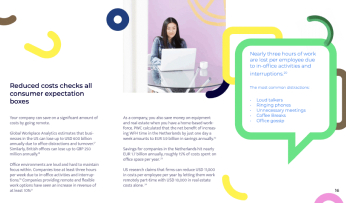One certainty has emerged unequivocally for businesses worldwide. After months of unpredictability following the pandemic, there’s an urgent need for effective remote performance management strategies for organisations across the board.
A significant percentage of the world’s population is now working remotely. At least half the U.S. workforce is currently in hybrid or fully remote setups, and work from home (WFH) may soon become a legal right in the Netherlands.
As virtual work culture spreads rapidly across nations, industries, and jobs, creating suitable guidelines for performance management for remote workers is critical.
The need of the hour for human resources (HR) today is to redefine employee objectives and key results (OKRs), work schedules, key performance indicators (KPIs), and review processes suitable for a remote environment. That’s where remote performance management comes in.
But how does it affect businesses?
Why does remote performance management matter?
The rapid adaptation of 2020-21 may have steadied into a more linear process of returning to ‘normal’, but the definition of normal has changed. Many brick-and-mortar establishments are transitioning to remote setups so supporting virtual teams is the best way forward for modern businesses, regardless of scale or industry.
Whether you’re prepared or not, your business will likely see significant growth in the remote work environment. And since it’s an entirely new way of working, it can’t be monitored nor managed by traditional processes.
For instance, in a physical office, you can monitor employee performance the traditional way by deploying a mix of objective evaluation, standard review processes, established policies, and personal observation.
But such methods do not migrate over easily to performance management for remote workers. Therefore, as a business, you must redefine employee engagement, team milestones, and performance reviews through a remote lens.
These days, the new normal is organisational agility, and performance management for remote workers is atop the list of challenges HR leaders must tackle in the coming year.
But effective remote performance management comes with a unique set of challenges for employers. Let’s look at what they are.
Challenges of remote performance management for businesses

For remote employees to achieve stated business goals and objectives, you must draw upon an effective remote performance management strategy.
Knowing how to motivate, train, guide, and lead your remote team is the key to success. But what kind of challenges can you expect on the way?
🚩 Over communicating or under communicating
For HR professionals, gauging employee performance in a physical office is straightforward. Management can observe where a team member is struggling and discuss actionable solutions based on their evaluations.
✋🏼 Performance management for remote workers requires a turn of thought and a more structured communication effort.
A heavy-handed or micromanaging approach might leave your employees feeling stifled and unhappy. Tone doesn’t transmit well over chats or text, and over-communicating with needless video calls can also exhaust a digitally fatigued workforce.
On the other hand, under-communicating with your team increases confusion and inhibits clarity on important objectives or workflows, resulting in poor performance. Additionally, regular feedback and appreciation gaps can also work as significant motivational setbacks for remote workers who may feel they’re operating inside a vacuum.
However, thoughtful performance management for remote workers can help you hit the sweet spot of communication, assuring you of clarity and collaboration within the team.
🚩 Misjudging healthy productivity levels
The inability to supervise remote work triggers management fears of employees neglecting their jobs at home. And many a manager may try to offset this by setting unrealistic goals and expectations for remote workers.
✋🏼 However, remote working is a new ballgame for employees and comes with its own challenges and stressors.
Remote employees cannot organically learn from you through observation, nor does physical isolation from co-workers nurture a conducive work environment. As a result, your team may not meet unrealistic objectives, and you might increase burnout and attrition as even high performers are left unable to cope with the pressure.
Effective remote performance management will help you avoid such pitfalls and set healthy expectations for your team.
🚩 Collaboration snags over distances and time-zones

Remote employees may work in different cities, days, hours, and time zones. Not everyone may log onto work at the same time or even on the same day, and for people in distant time zones, it might be nighttime when it’s daytime in your part of the world.
✋🏼 ‘Immediacy’ acquires a different meaning in a remote work set-up.
So what should you do when you’re online but an employee you need to consult isn’t? Holding impromptu team meetings can also be challenging when some of your team members don’t work on those days or during those hours.
Remote performance management helps ensure effective collaboration between you and your remote employees in such situations.
🚩 Difficulties in evaluating remote employee performance
When nobody’s in the office and communication occurs purely through online channels, performance management for remote employees requires reconsidering how you evaluate and track their progress as opposed to in-office teams.
✋🏼 Monitoring and measuring employee performance can be tricky in remote environments.
For example, in brick-and-mortar establishments, employees who stay back late or reach work early tend to be subjectively viewed as hard workers or dedicated performers. In addition, their proximity to superiors and bosses may speed up skills acquisition and growth opportunities for selected employees through mentor training.
However, this process isn’t entirely free of bias, and in a remote environment, such methods won’t work with employees and bosses physically separated from each other.
So how do you ensure you’re monitoring remote employee performance and growth the right way?
4 tips for effective remote performance management:

Performance management for remote workers is a new paradigm for businesses everywhere, but the good news is that it isn’t hard to get right. All you have to do is reconsider what employee needs, OKRs, and KPIs look like in your remote performance management process.
Here’s how to make the best of it with your team:
🌼 Don’t overburden, follow a realistic progress agenda
Consider the limitations and strengths of your remote employees and design achievable goals together. Keep empathy and support at the forefront of your leadership style.
✒️ It helps to remember that employees want to deliver on their targets. Overburdening them out of fear of unproductivity negatively impacts organisational well-being, goal metrics, and retention rates.
Moreover, fears of WFH unproductivity are primarily unfounded as many surveys have reported worker productivity actually increasing with remote work.
Minus the exhaustion of the daily commute and workplace distractions powers a healthier work-life balance for remote workers. It drives motivation, loyalty, and well-being, which help people focus better at work.
Ensuring your remote performance management strategy is setting healthy goals and supporting employee experience helps you get the best out of your team.
🌷 Trust employees and stay flexible in work hours/shifts
Allow remote employees the flexibility to define their own work hours and off-time. One of the biggest advantages of remote work is the freedom to discard old-fashioned workflows and methods.
✒️ You’ll be surprised at how moving away from a traditional 9-5 schedule can qualitatively improve the work produced instead of inhibiting it.
Some people may function better as night owls, and others may need a siesta before they put in a solid five hours of work in the evening. Trust your employees to know what works for them.
By focusing on their achievements and not on outdated methods, you free your team to deliver high-quality work in a way that suits them. As long as you’re happy with the results, you don’t need to control how your employees achieve them.
🌻 Open healthy communication channels and set clear expectations

With employees not physically present in an office, getting office news at the water cooler or even chatting with co-workers takes more effort than you think. So if you want to manage a remote team that functions smoothly, creating healthy and open lines of communication is a must.
But with conversations taking place virtually, it’s easy for communication to get siloed, creating favouritism within teams or reducing connection between departments.
✒️ Devise virtual strategies to involve inter-departmental employees in inclusive communication, from personal action plans to larger business goals. Work on a culture of inclusion so that shy or less extroverted remote workers aren’t left out.
Focus on equal employee engagement in video conferencing calls by encouraging each team member to open up during face-to-face sessions. And ensure every employee knows what’s expected in the coming week, quarter, or annual review.
Employees should never feel left in the dark regarding upcoming developments, planned activities, and business milestones or be confused about key objectives and goals. If they are, the communication failure is at your end, not theirs.
🌹 Provide positive feedback and personal mentoring
Working in isolation can be emotionally taxing and lonely, making positive feedback and regular work appreciation one of your remote workers’ biggest motivators and drivers.
WFH employees need to feel their contributions are valued more regularly than you expect. You should never forget that these employees are cut off from each other and from you. They don’t have easy exposure to your experience, nor can they access in-person learning from co-workers. So they need to know when they’re doing things well.
✒️ Outline a feedback-driven, connected, and growth-focused strategy for your team. Identify strengths, pain points, and deliverables for remote employees, and realign your expectations, training, and performance evaluations to match.
Remote teams need a well-thought-out mentoring strategy from leaders and bosses so they can upskill and take on higher roles and responsibilities.
Have meaningful one-on-one conversations with your employees instead of the lip-service in weekly follow-ups. Make each check-in talk with them count. Discuss their professional aspirations and interests, design mentorship modules for acquiring higher job skills, and guide their growth within the organisation.
Remember to set aside time for casual chats so you can connect on a personal, human level.
Transitioning to remote performance management

Your remote performance management approach should be advantageous to your employee experience and business goals. Focus on team upskilling, healthy collaboration, and overall growth. Abandon outdated ideas and processes that don’t support these goals.
Remember, many default management behaviours that might have worked in traditional offices don’t work in a remote setup. So don’t be afraid to carve out a new leadership path.
Having your workers’ best interests at heart and leading with empathy is the best way to boost loyalty, motivation, and growth.
Now that you know the four simple steps to effective remote performance management, you might want to put all these handy tips to practise. Why not explore the best of what remote work offers by going remote with your customer service?
The Cocoroco platform connects you with the skilled, high-quality global talent to meet all your customer service needs. Our language-specialist agents come pre-vetted, qualified, and highly motivated to work for you. And our online hiring process is quick, legally compliant, and hassle-free.
Interested in knowing more? Book a free demo with us for a no-strings-attached call on how we can help you scale your customer support.
We believe happy customers keep businesses happy. That’s how Cocoroco works for you.










